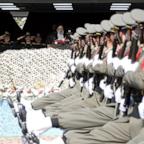Space Junk: NASA Now Predicts Satellite Re-Entry Tonight or Saturday Morning
NASA updates forecast, expects re-entry tonight.
Sept. 23, 2011— -- Re-entry of NASA's abandoned UARS satellite into earth's atmosphere is expected late today or early Saturday, the space agency said in a new update. During that time period, the satellite will be passing over Canada, Africa and Australia, and vast areas of the Pacific, Atlantic and Indian oceans. NASA said the risk to public safety is very remote.
"The satellite's orientation or configuration apparently has changed, and that is now slowing its descent," said NASA in an update. "There is a low probability any debris that survives re-entry will land in the United States, but the possibility cannot be discounted because of this changing rate of descent."
At last report, UARS's orbit was 90 miles by 95 miles. The atmosphere there, thin as it is, is thick enough to slow the satellite until it finally cannot stay in orbit.
The Aerospace Corporation, a private firm in California that is tracking UARS, independently predicted the satellite would come down around 11:16 p.m. EST, in an oval area that includes countries in northern Africa from Libya to Chad. But it said the time could change by several hours.
NASA said some 26 chunks of the old satellite -- which is roughly the size of a bus -- are likely to survive the descent, and fall at hundreds of miles per hour over an area of some 500 square miles. The agency has said it knows of no case in which people have been hurt by space junk.
"We believe that the risk is sufficiently low that no one needs to change their behaviors," NASA's Mark Matney said.
This is the largest NASA satellite to fall back to Earth uncontrolled since Skylab in 1979. Skylab was much larger -- about the size of a house -- and debris fell in the Australian Outback and the Pacific.
Bill Ailor, principal engineer at the Aerospace Corp., studies incoming space junk for the Air Force. He said pieces of other satellites have come crashing down into villages, farms and random datelines around the planet.
"I actually think a lot of this kind stuff comes down and nobody knows what it is and just thinks it's junk and ignores it," Ailor told ABC News.
Ailor and his colleagues study satellite components in a lab to figure out what will burn up and what will become a potential threat -- just like the pieces of the UARS satellite.
But according to Nicholas Johnson, NASA's chief orbital debris scientist, any one person's chances of getting hit by debris are tiny -- something like 1 in 21 trillion. The chances that of the 7 billion people on Earth, one of them, somewhere, could be hit are more like 1 in 3,200.
Despite those odds, Ailor said that a hazard is a hazard.
"Five hundred pounds of stainless steel represents a hazard -- if you're standing under it," Ailor joked.
ABC News' Neal Karlinsky contributed to this report.




